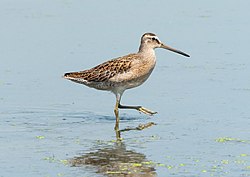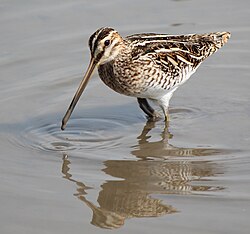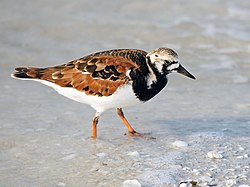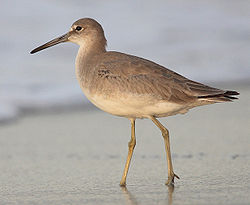| Image | Genus | Living and recently extinct species |
|---|
 | Bartramia F. Boie, 1826 | |
 | Numenius Brisson, 1760 | |
 | Limosa Brisson, 1760 | |
 | Limnodromus Wied-Neuwied, 1833 | |
 | Lymnocryptes F. Boie, 1826 | |
 | Scolopax Linnaeus, 1758 | |
 | Coenocorypha G. R. Gray, 1855 | - † North Island snipe, Coenocorypha barrierensisOliver, 1955 – also known as the Little Barrier Snipe
- † South Island snipe, Coenocorypha iredaleiRothschild, 1921 – also known as the Stewart Island Snipe
- Chatham snipe, Coenocorypha pusilla(Buller, 1869) – Chatham Islands
- Snares snipe, Coenocorypha huegeli(Tristram, 1893) – Snares Islands
- Subantarctic snipe, Coenocorypha aucklandica(G. R. Gray, 1845)
- Auckland snipe, C. a. aucklandica(G. R. Gray, 1845) – Auckland Islands
- Antipodes snipe, C. a. meinertzhagenaeRothschild, 1927 – Antipodes Islands
- Campbell snipe, C. a. perseveranceMiskelly & Baker, 2010 – Campbell Island
- † Forbes's snipe, Coenocorypha chathamica(Forbes, 1893) – Chatham Islands
- † Viti Levu snipe, Coenocorypha miratropicaWorthy, 2003 – Fiji
- † New Caledonian snipe, Coenocorypha neocaledonicaWorthy et al., 2013 – New Caledonia
- † Norfolk snipe, Coenocorypha sp. – Norfolk Island
|
 | Gallinago Brisson, 1760 | - Imperial snipe, Gallinago imperialis
- Jameson's snipe, Gallinago jamesoni
- Fuegian snipe, Gallinago stricklandii
- Solitary snipe, Gallinago solitaria
- Wood snipe, Gallinago nemoricola
- Great snipe, Gallinago media
- Swinhoe's snipe, Gallinago megala
- Pin-tailed snipe, Gallinago stenura
- Latham's snipe, Gallinago hardwickii
- African snipe, Gallinago nigripennis
- Common snipe, Gallinago gallinago
- Wilson's snipe, Gallinago delicata
- Giant snipe, Gallinago undulata
- Noble snipe, Gallinago nobilis
- Puna snipe, Gallinago andina
- Madagascar snipe, Gallinago macrodactyla
- Pantanal snipe, Gallinago paraguaiae
- Magellanic snipe, Gallinago magellanica
|
 | Phalaropus Brisson, 1760 | |
 | Xenus Kaup, 1829 | |
 | Actitis Illiger, 1811 | |
 | Tringa Linnaeus, 1758 | - Green sandpiper, Tringa ochropus
- Solitary sandpiper, Tringa solitaria
- Grey-tailed tattler, Tringa brevipes (formerly Heteroscelus brevipes)
- Wandering tattler, Tringa incana (formerly Heteroscelus incanus)
- Marsh sandpiper, Tringa stagnatilis
- Wood sandpiper, Tringa glareola
- Common redshank, Tringa totanus
- Lesser yellowlegs, Tringa flavipes
- Nordmann's greenshank, Tringa guttifer
- Willet, Tringa semipalmata (formerly Catoptrophorus semipalmatus)
- Spotted redshank, Tringa erythropus
- Common greenshank, Tringa nebularia
- Greater yellowlegs, Tringa melanoleuca
|
 | Prosobonia Bonaparte, 1850 | |
 | Arenaria Brisson, 1760 | |
 | Calidris Merrem, 1804 | - Great knot, Calidris tenuirostris
- Red knot, Calidris canutus
- Surfbird, Calidris virgata
- Ruff, Calidris pugnax
- Broad-billed sandpiper, Calidris falcinellus
- Sharp-tailed sandpiper, Calidris acuminata
- Stilt sandpiper, Calidris himantopus
- Curlew sandpiper, Calidris ferruginea
- Temminck's stint, Calidris temminckii
- Long-toed stint, Calidris subminuta
- Red-necked stint, Calidris ruficollis
- Spoon-billed sandpiper, Calidris pygmaea
- Buff-breasted sandpiper, Calidris subruficollis
- Sanderling, Calidris alba
- Dunlin, Calidris alpina
- Purple sandpiper, Calidris maritima
- Rock sandpiper, Calidris ptilocnemis
- Baird's sandpiper, Calidris bairdii
- Little stint, Calidris minuta
- Least sandpiper, Calidris minutilla
- White-rumped sandpiper, Calidris fuscicollis
- Pectoral sandpiper, Calidris melanotos
- Western sandpiper, Calidris mauri
- Semipalmated sandpiper, Calidris pusilla
|
|























